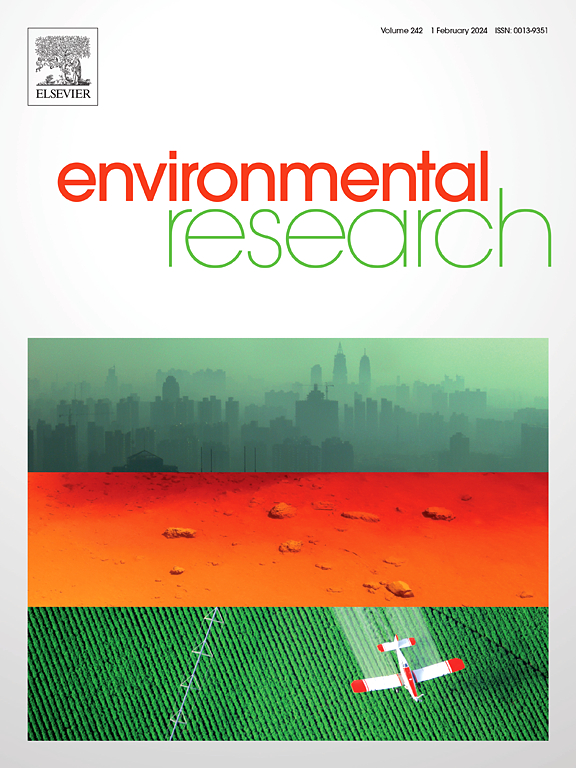追踪4岁、8岁和14岁儿童早期PFAS暴露:一项来自INMA西班牙出生队列的纵向研究
IF 7.7
2区 环境科学与生态学
Q1 ENVIRONMENTAL SCIENCES
引用次数: 0
摘要
近年来,PFAS的广泛使用,加上其持久性和流动性,已导致全球环境污染和人类生物积累。绘制关键发育阶段(4岁、8岁和14岁)儿童的PFAS暴露图谱,对于评估早期暴露及其与居住地、生理性别和潜在健康结果的关系至关重要。在这项工作中,我们分析了来自Gipuzkoa两个地区的207名幼儿、241名儿童和167名青少年的血浆样本,这些样本来自INMA Gipuzkoa西班牙出生队列(2011-2022),用于42种靶向PFAS。结果证实了18种不同的PFAS,包括长链和短链同源物、前体和新出现的PFAS。检出最多的PFAS为PFOS、PFOA、PFNA、PFDA和PFHxS,检出率为70 ~ 97%。在4岁时,儿童显示出最高的检测频率,而短链PFAS检测(PFBA, FPrPA, PFBS, PFPeA)在他们进入青春期后增加,这表明环境暴露模式发生了变化。来自乌罗拉地区的样本浓度较高,在26-35%的14岁男性和女性中超过了4种PFAS (PFNA, PFOA, PFOS, PFHxS)的慢性暴露限值。该地区的PFOA浓度在8年至14年随访期间尤其增加,表明随访期间存在暴露。在总PFAS负担方面,两性之间没有显著差异,但在14岁时,男性个体PFAS总体水平较高。采用文献中的偏离点进行的危险商数评估表明,在一般研究人群中,对肝脏和发育的影响没有风险或中度风险。最后,多元线性回归模型显示,母亲PFAS水平和母乳喂养时间与儿童早期发育阶段PFAS浓度呈正相关,而环境或区域因素随着年龄的增长影响更大。在模型中,父母的社会经济地位并没有成为一个显著的预测因素。本文章由计算机程序翻译,如有差异,请以英文原文为准。

Tracking early-life PFAS exposure in children at ages 4, 8, and 14 years: A longitudinal study from the INMA Spanish birth cohort
In recent times, the widespread use of PFAS, combined with their persistence and mobility, has led to global environmental contamination and human bioaccumulation. Mapping PFAS exposure in children at critical developmental stages (4, 8, and 14 years) is essential to assess early exposure and its relationship with living place, biological sex and potential health outcomes. In this work, plasma samples from two regions of Gipuzkoa have been analyzed from 207 children at early childhood, 241 children, and 167 adolescents in the INMA Gipuzkoa Spanish birth cohort (2011–2022) for 42 targeted PFAS. The results confirmed 18 different PFAS, including long and short-chain congeners, precursors, and emerging PFAS. The most detected PFAS were PFOS, PFOA, PFNA, PFDA, and PFHxS, with detection frequencies of 70–97 %. At 4 years, children showed the highest detection frequencies, while short-chain PFAS detection (PFBA, FPrPA, PFBS, PFPeA) increased when they reached puberty indicating a change on the environmental exposure patterns. The samples coming from the Urola region showed higher concentrations, exceeding the EFSA limit for chronic exposure to sum of 4 PFAS (PFNA, PFOA, PFOS, PFHxS) in 26–35 % of 14-year-old males and females. PFOA concentrations, in particular, increased between the 8- and 14-year follow-up in this region indicating an exposure between follow-ups. No significant differences were found between sexes for the total PFAS burden but for individual PFAS with overall higher levels in males at 14 years. Hazard quotient assessments employing points of departure taken from literature indicated no risk or moderate risk for hepatic and developmental effects in the general studied population. Finally, multivariate linear regression models showed that maternal PFAS levels and breastfeeding duration were positively associated with children's PFAS concentrations in early development, while environmental or regional factors became more influential with age. Parental socioeconomic status did not emerge as a significant predictor in the models.
求助全文
通过发布文献求助,成功后即可免费获取论文全文。
去求助
来源期刊

Environmental Research
环境科学-公共卫生、环境卫生与职业卫生
CiteScore
12.60
自引率
8.40%
发文量
2480
审稿时长
4.7 months
期刊介绍:
The Environmental Research journal presents a broad range of interdisciplinary research, focused on addressing worldwide environmental concerns and featuring innovative findings. Our publication strives to explore relevant anthropogenic issues across various environmental sectors, showcasing practical applications in real-life settings.
 求助内容:
求助内容: 应助结果提醒方式:
应助结果提醒方式:


